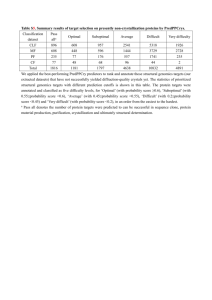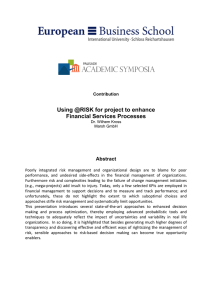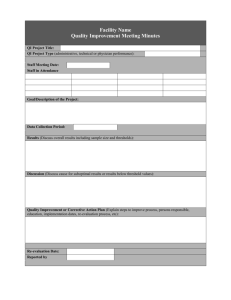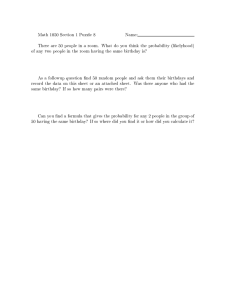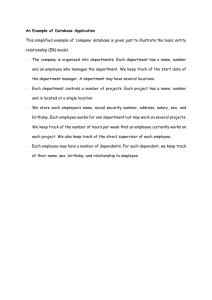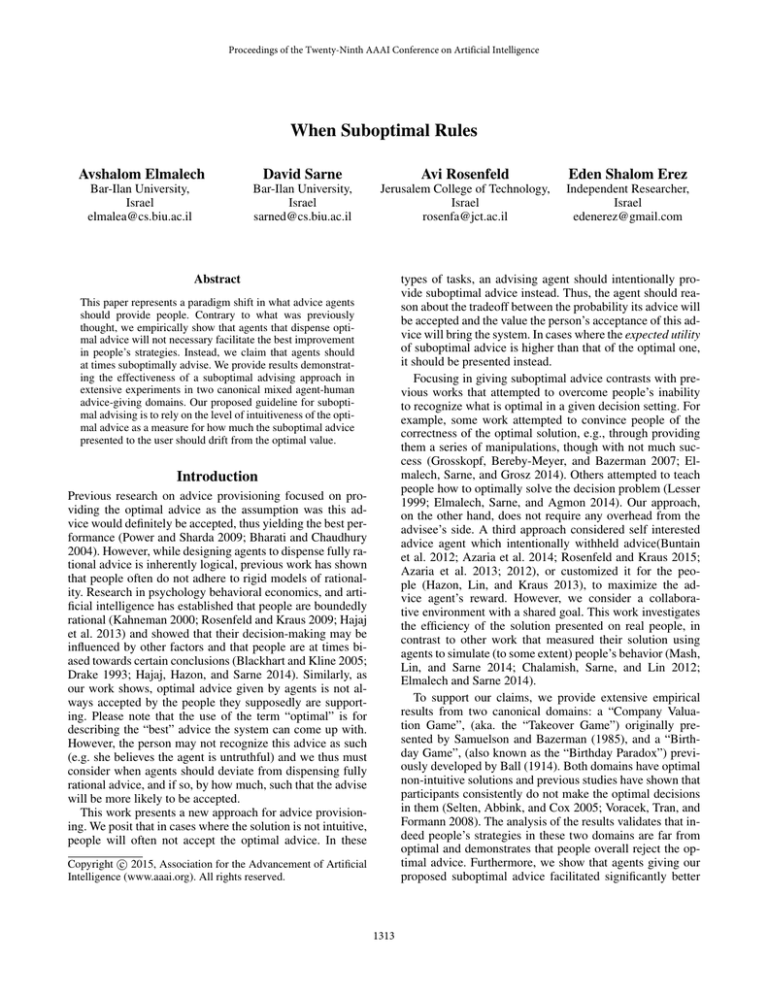
Proceedings of the Twenty-Ninth AAAI Conference on Artificial Intelligence
When Suboptimal Rules
Avshalom Elmalech
David Sarne
Avi Rosenfeld
Eden Shalom Erez
Bar-Ilan University,
Israel
elmalea@cs.biu.ac.il
Bar-Ilan University,
Israel
sarned@cs.biu.ac.il
Jerusalem College of Technology,
Israel
rosenfa@jct.ac.il
Independent Researcher,
Israel
edenerez@gmail.com
Abstract
types of tasks, an advising agent should intentionally provide suboptimal advice instead. Thus, the agent should reason about the tradeoff between the probability its advice will
be accepted and the value the person’s acceptance of this advice will bring the system. In cases where the expected utility
of suboptimal advice is higher than that of the optimal one,
it should be presented instead.
Focusing in giving suboptimal advice contrasts with previous works that attempted to overcome people’s inability
to recognize what is optimal in a given decision setting. For
example, some work attempted to convince people of the
correctness of the optimal solution, e.g., through providing
them a series of manipulations, though with not much success (Grosskopf, Bereby-Meyer, and Bazerman 2007; Elmalech, Sarne, and Grosz 2014). Others attempted to teach
people how to optimally solve the decision problem (Lesser
1999; Elmalech, Sarne, and Agmon 2014). Our approach,
on the other hand, does not require any overhead from the
advisee’s side. A third approach considered self interested
advice agent which intentionally withheld advice(Buntain
et al. 2012; Azaria et al. 2014; Rosenfeld and Kraus 2015;
Azaria et al. 2013; 2012), or customized it for the people (Hazon, Lin, and Kraus 2013), to maximize the advice agent’s reward. However, we consider a collaborative environment with a shared goal. This work investigates
the efficiency of the solution presented on real people, in
contrast to other work that measured their solution using
agents to simulate (to some extent) people’s behavior (Mash,
Lin, and Sarne 2014; Chalamish, Sarne, and Lin 2012;
Elmalech and Sarne 2014).
To support our claims, we provide extensive empirical
results from two canonical domains: a “Company Valuation Game”, (aka. the “Takeover Game”) originally presented by Samuelson and Bazerman (1985), and a “Birthday Game”, (also known as the “Birthday Paradox”) previously developed by Ball (1914). Both domains have optimal
non-intuitive solutions and previous studies have shown that
participants consistently do not make the optimal decisions
in them (Selten, Abbink, and Cox 2005; Voracek, Tran, and
Formann 2008). The analysis of the results validates that indeed people’s strategies in these two domains are far from
optimal and demonstrates that people overall reject the optimal advice. Furthermore, we show that agents giving our
proposed suboptimal advice facilitated significantly better
This paper represents a paradigm shift in what advice agents
should provide people. Contrary to what was previously
thought, we empirically show that agents that dispense optimal advice will not necessary facilitate the best improvement
in people’s strategies. Instead, we claim that agents should
at times suboptimally advise. We provide results demonstrating the effectiveness of a suboptimal advising approach in
extensive experiments in two canonical mixed agent-human
advice-giving domains. Our proposed guideline for suboptimal advising is to rely on the level of intuitiveness of the optimal advice as a measure for how much the suboptimal advice
presented to the user should drift from the optimal value.
Introduction
Previous research on advice provisioning focused on providing the optimal advice as the assumption was this advice would definitely be accepted, thus yielding the best performance (Power and Sharda 2009; Bharati and Chaudhury
2004). However, while designing agents to dispense fully rational advice is inherently logical, previous work has shown
that people often do not adhere to rigid models of rationality. Research in psychology behavioral economics, and artificial intelligence has established that people are boundedly
rational (Kahneman 2000; Rosenfeld and Kraus 2009; Hajaj
et al. 2013) and showed that their decision-making may be
influenced by other factors and that people are at times biased towards certain conclusions (Blackhart and Kline 2005;
Drake 1993; Hajaj, Hazon, and Sarne 2014). Similarly, as
our work shows, optimal advice given by agents is not always accepted by the people they supposedly are supporting. Please note that the use of the term “optimal” is for
describing the “best” advice the system can come up with.
However, the person may not recognize this advice as such
(e.g. she believes the agent is untruthful) and we thus must
consider when agents should deviate from dispensing fully
rational advice, and if so, by how much, such that the advise
will be more likely to be accepted.
This work presents a new approach for advice provisioning. We posit that in cases where the solution is not intuitive,
people will often not accept the optimal advice. In these
c 2015, Association for the Advancement of Artificial
Copyright Intelligence (www.aaai.org). All rights reserved.
1313
This can be done by collecting data of people’s decisions in
similar decision situations when no advice is given. Other alternatives include interviewing people or simply relying on
common sense and/or psychological biases reported in literature. Yet, it seems that the question of “what is intuitive” to
people is unavoidable and should be addressed in any future
architecture of suboptimal advising agents.
performance that those giving the optimal advice.
Sub-Optimal Advice Giving Approach
As previous work into bounded rationality would imply,
and as our results support, people do not always accept
an agent’s optimal advice. Consequently, and in contrast to
all previous research known to us, we claim that a category of problems exists where the optimal solution is nonintuitive and thus less likely to be accepted by people. In
these cases, suboptimal advice should be given. More formally, we model the decision making process as follows.
Assume that agent A can either provide the optimal advice
∗
AD∗ with a utility of V AD if adopted by the user, or sub0
optimal advice AD0 with utility V AD . We further assume
that A can autonomously choose between which advice to
dispense (either AD∗ or AD0 ) to a person X. In theory, the
system’s utility will be maximized when AD∗ is chosen as
∗
0
V AD > V AD . However, in practice, when providing any
advice AD ∈ {AD∗ , AD0 }, it is possible that X will prefer
following AD00 , which she mistakenly believes to be optimal, instead. Therefore, the expected utility from providing
00
an advice AD is given by P (AD) · (V AD − V AD ) where
P (AD) is the probability the advised subject will adopt the
00
advice given and V AD is the utility from what she would
have chosen to follow if not receiving the advice in the first
place. The system’s expected-utility-maximizing advice is
thus given by argmaxAD P (AD) · V AD . Thus, in practice,
the agent should reason about the relative probability X will
accept both advices.
This solution concept posses several challenges, such as
intelligently generating suboptimal advices that will seem
appealing to people in different decision settings, or predicting the probability a given advice (either optimal or a suboptimal one) will be accepted by the advisee. In addition,
the above calculation is a bit naive as it assumes X would
have used AD00 even if not given the advice AD. In reality, of course, it is possible that giving the advice AD will
result in changing what X considers to be optimal, and this
also needs to be modeled. The design we propose in this paper attempts to bypass these complexities—while we do not
fully attempt to solve for argmaxAD P (AD) · V AD (or any
of its more complicated versions) we do follow the principle
of giving a slightly suboptimal advice that is more likely to
be accepted by the advisee.
Our general design relies on the level of intuitiveness of
the optimal advice in a given decision situation. The greater
the non-intuitiveness, the greater the drift in the advice generated towards what might seem to be intuitive (and thus
highly appealing) to people in general. The limitation of this
design is that it only fits domains where the suboptimal advice’s utility monotonically decreases with respect to that
advice’s distance from the optimal one, and where the distance parameter is well defined. Nevertheless, as we show in
the following section, both canonical domains we consider
for our experiments satisfy these conditions. A second limitation of this approach is that it requires the system designer
to hypothesize what constitutes highly intuitive advice, towards which the proposed suboptimal advice should drift.
Domains Descriptions
Company Valuation (Samuelson and Bazerman 1985)
In this game there are two players: a seller of a company
and a buyer interested in buying it. The true value of the
company, denoted by pseller , is privately held by the seller.
The buyer’s best assessment is that the company’s worth is
equally likely to be any number (i.e., uniformly distributed)
between 0 and 100. The buyer knows that she can improve
the value of the company by factor x. The buyer needs to
come up with a “take it or leave it” offer to the seller. Thus, if
the buyer’s offer for the company, denoted Obuyer , is above
pseller , the seller will accept it, and the buyer’s profit will be
x · pseller − Obuyer . Otherwise the offer will be rejected and
the buyer’s profit will be zero. The buyer’s goal in this game
is to maximize her expected benefit.
Assuming the seller is willing to accept the offer for
Obuyer , the buyer updates his assessment to conclude that
pseller is uniformly distributed between 0 and Obuyer , with
O
a rational expectation of buyer
. The expected profit of the
2
Obuyer
O
(x−2)
buyer in this case is thus: x· 2 −Obuyer = buyer2
,
meaning that the buyer’s optimal strategy in this game solely
depends on the value x: for x < 2 the optimal strategy is
to offer zero, whereas the optimal strategy for x > 2 is
to offer 100. This is illustrated in Figure 1(a). While the
game is easy to understand and its optimal strategy is relatively easy to compute, the solution is found to be highly
non-intuitive for people, and indeed prior work reports substantial deviation in people’s offers from the optimum in
experiments (Samuelson and Bazerman 1985). The main
non-intuitiveness in the optimal solution is that although the
company is known to be worth more to the buyer than to the
seller, the optimal solution within the range 1 < x < 2 is
not to purchase it at all, and for x > 2 to make an offer that
is the maximum worth of the company to the seller. In particular, the sharp transition from offering 0 to 100, exactly at
x = 2, is confusing to people.
Birthday (Ball 1914) In this game the participant needs to
calculate the probability that in a class of N students, there
will be at least two students celebrating their birthday on the
same day. The correct answer is calculated as follows. First
¯ ) that all N birthdays are
we calculate the probability p(N
363
366−N
366−i
364
¯ ) = 1·
= ΠN
different: p(N
i=1 365 . The
365 · 365 · · · 365
probability that at least two students celebrating their birth¯ ). Figure
day on the same day, denoted p(N ) is thus 1 − p(N
1(b) depicts the probability p(N ) as a function of the number
of students in the class, N . As in Company Valuation game,
this game is easy to explain, yet in contrast it is difficult for
people to calculate the optimal strategy, as the mathemati-
1314
Experimental Design
We implemented both games such that participants could interact with the system using a relatively simple graphical
interface, thus facilitating interactions with a variety of people. Participants were recruited and interacted through Amazon Mechanical Turk(AMT) (AMT 2010).2 Each participant
took part in one out of three treatments: (a) playing the game
without an advisor; (b) playing the game with the optimal
advisor; and (c) playing the game with our suboptimal advisor. From the user-interface point of view, the advice was
presented to participants by a virtual advisor that outputted
its advice (e.g., the amount to offer for the Company Valuation or the probability in the Birthday game) though the participant was free to input any value as a response. Overall,
we had 50 different participants for each treatment in each
game (300 participants overall). Participants differed in age
(21-60) and gender (37% men and 63% women). Each participant received thorough instructions of the game rules and
her goal in the game. Participants were told of the compensation structure, which was composed of a show-up fee (the
basic “HIT”) and a bonus which was linear in the participant’s performance in the experiment in order to encourage
thoughtful participation. For the Company Valuation game,
performance was measured as the average profit in all games
played. For the Birthday game, performance was measured
as the average absolute deviation from p(N ) in the games
played.
After the instructions step, participants were asked to engage in practice games which they were encouraged to repeat until stating that they understood the games’ rules and
had developed a game strategy (with a strict requirement for
playing at least two practice games). Then, participants had
to correctly answer a short quiz before continuing to the experiments whose results we logged for this study.
The experiment protocol for the Company Valuation
game was as follows. Participants were asked to play
10 times the buyer side of the game, each time with
a different (randomly selected) x value from the set
{1, 1.2, 1.4, 1.6, 1.8, 2.2, 2.4, 2.6, 2.8, 3}, i.e., five values for
which the optimal strategy is 0 and five for which it is
100. The decision to require participants to play 10 games
was made primarily in order to push them to use their
expected-benefit maximizing strategy. It has been shown
that in repeated-play settings people’s strategies asymptotically approach the expected monetary value (EMV) strategy as the number of repeated plays increases (Wedell 2011;
Klos, Weber, and Weber 2005; Keren and Wagenaar 1987;
Barron and Erev 2003). In particular, the probability a person will prefer the option associated with the highest expected value is substantially greater than in single-play settings (Montgomery and Adelbratt 1982). To avoid any learning and carryover effects, participants were told that on each
iteration they will be facing a different seller and a different company offered for sale. For the same reason, we did
not inform participants of their result after each game was
played, and they discovered the value of the company to the
Figure 1: The optimal advice; (a) Company Valuation, and
(b) Birthday game.
cal truth in this case contradicts people’s intuition (Voracek,
Tran, and Formann 2008). The non-intuitiveness of p(N )
in this case may derive from people’s tendency to estimate
probability by “assessing availability”, or using “associative
distance” (Tversky and Kahneman 1973). For example, one
may estimate the probability of at least two people sharing
the same birthday by counting the people she knows that
share the same birthday as hers.
Advice Generation in Birthday Game and
Company Valuation Game
Following our general approach that was outlined above in
the “advice giving approach” section, we designed an advising agent for each of the two games that is capable of providing suboptimal advice. For the Company Valuation game
we hypothesized that the greater the distance of the value of
x from x = 2, the more intuitive the optimal solution would
seem to people, where proposing the optimal solution for
x < 1 or x > 3 is fully intuitive. This is straightforward, as
the lower the value of x, the smaller the expected worth of
the company to the buyer, making it more likely the person
will accept low offers. Specifically, our advising agent provided the advice Obuyer = 50 · (x
− 1)3 for 1 < x < 2 (and
√
5
0 for x < 1), and Obuyer = 50 · x − 2 + 50 for 2 < x < 3
(and 100 for x > 3), though any other functions following
the above monotonicity principle are applicable. 1
For the Birthday game we hypothesized that misunderstanding p(N ) is rooted in the rapidness of change in the
probability as the number of students (N ) increases—the
larger the rate of change, the less intuitive the optimal advice is to people. Therefore, our advising agent was designed to rely on the first derivative of p(N ) as a measure
for the amount of deviation required from the true answer.
Specifically, we used the function p(N )t = p(N ) − 6 · N ·
dp(N )/dN . Here, the coefficient 6 was set arbitrarily to determine the maximal deviation allowed from the optimal advice.
1
Since the goal of this paper is to provide a proof of concept we did not focus on finding the function that would provide
the “best” performance and arbitrarily set what seemed to “make
sense”. Also, our preference of a function with a slightly lesser aggressive convergence to the optimal value for x > 2 (compared
to x < 2) is rooted in the different extent of non-intuitiveness of
the optimal advice in both cases — as discussed in the previous
section, the optimal advice for x < 2 is less intuitive for people.
2
For a comparison between AMT and other recruitment methods see (Paolacci, Chandler, and Ipeirotis 2010).
1315
timal and suboptimal), as a function of the value x, similar
to the graph given in Figure 2. In fact, the curve for the case
where no advice is provided is the same as the one given in
2(a). The two other graphs of the figure comparatively show
the distribution of offers made between the three treatments.
Here, in contrast to 2, we present the aggregative data for all
x < 2 and x > 2 values, due to space considerations. This
figure shows that providing the optimal advice facilitates an
improvement in the average offer made. Yet, from the distribution of offers we observe that the offers made are still
relatively far from optimal: for the case of x < 2 only 35%
of participants adopted the optimal or near-optimal strategy
(middle graph). This combination of a relatively large improvement in the average offer and a relatively low percentage of participants adopting the optimal offer suggests that
while giving the optimal advice does not lead people to an
optimal offer, it does push them towards better ones. From
Figure 3(b) we see the improvement in the percentage of
participants that offered optimal or near-optimal amounts
was almost entirely at the expense of the classes offering
very far from optimal (offers greater than 50). For the case
of x > 2 (right graph), we observe a similar pattern—a
transition from far-from-optimal offers to optimal and nearoptimal ones—though in this case the improvement is of a
greater extent: almost 43% of the offers made are optimal
or near-optimal and the improvement is at the expense of all
other offer classes, i.e., of offers smaller than 90. The larger
improvement in the x > 2 case is attributed the fact that
the optimal strategy is more intuitive here compared to the
x < 2 case as discussed above.
The suboptimal advice yielded an even greater improvement, both in the average offer made and the distributions of
offers, compared to those achieved with providing the optimal advice: 64% of the offers made for x > 2 and 40% of
the offers made for x < 2 were optimal and near-optimal. As
expected, the improvement is mostly noticeable in the percentage of the near-optimal offers. Interestingly, for x > 2
we do observe an improvement in the percentage of participants that used the optimal strategy, despite receiving the
suboptimal advice. These mostly correspond to the case of
x = 3, for which the suboptimal advice equals the optimal
one, according to our design, where 52%(!) of the participants used the optimal offer. However, even in other x > 2
cases we see that 16 − 30% (increasing as x increases) of
participants used the optimal offer despite being provided
a slightly lower one. We believe this is because, similar to
the explanation given above, even the rejected advice has
the power to change a person’s strategy. In this case, therefore, people who gave the optimal offer were affected by the
suboptimal advice in a way that made them realize that the
optimal strategy is indeed to offer as much as possible.
One interesting finding in Figure 3(a) is that there is a
difference between the average offer when using the optimal and suboptimal advices, both for the case of x = 1 and
x = 3 (and similarly a difference between the offers distributions in these cases) In these two cases our suboptimal
advice was the same as the optimal advice (as discussed in
the previous section). Seemingly, this should have led to the
same offers. Yet, the results reflect a substantial change in
seller and their corresponding profits in all games through a
summary table which was only visible after completing the
experiment.
The experiment protocol for the Birthday game
was similar, except that each participant had to play
only 5 games, differing in the number of students
in the class (N , randomly selected from the set
{17, 25, 38, 51, 70} with corresponding true probabilities of {31.5%, 56.8%, 86.4%, 97.4%, 99.9%}). For each
game, the participant was informed of the value of N and
was asked to input the probability of having at least two
people celebrating their birthday on the same day.
Results and Analysis
Company Valuation Results
Figure 2(a) depicts the average offer made by participants
in the Company Valuation game for different values of x.
The two other graphs of the figure show the distribution of
offers made, for x < 2 and x > 2 values, according to six
classes of offers: the first is the optimal offer (0 and 100, depending on x), the second is of near-optimal offers (within a
distance of 10 from the optimal offer) and the remaining are
of classes progressively far from optimal offers. These results align with those reported by Samuelson and Bazerman
(1985) who experimented in this domain with x = 1.5 settings, hence further validating our experiments– while they
reported that 38% of their MBA students offered 60$ and
more, the analysis of our data for x = 1.6 reveals that 36%
of the participants offered 60$ and more.
As can be observed from the figure, participants’ offers
were mostly far from optimal for all x values, with a greater
tendency to provide non-optimal offers for x < 2 values.
Only 3% of the participants (averaging over the different x
conditions) used the optimal offer. The size of near-optimal
class was also small, with a slight advantage to the case
where x > 2. Peoples’ greater tendency to provide a nonoptimal offer for x < 2 values may suggest that while the
solution of both cases is non-intuitive, the x < 2 case is
less intuitive than the x > 2 one, hence supporting the use
of a non aggressive convergence to the optimal strategy as
reported in our advice generation design. Furthermore, the
graph supports our hypothesis that the greater the distance
from x = 2, the closer we get to the optimal solution (and
implicitly, the greater the intuitiveness of the optimal solution). This is exemplified by the decrease in the average offer
as x decreases, for x < 2, and the increase in the average offer as x increases, for x > 2. It is also nicely evidenced in
the distribution of offers: with both the increase in the value
of x (for the case of x < 2) and the decrease in the value
(for x > 2) we observe an increase in the percentage of participants that use the optimal or the near-optimal strategies.
This increase becomes even sharper when switching to the
two extremes at x = 1 and x = 3.
Figure 3 compares the offers made by participants when
given an optimal and suboptimal advices and those made by
participants when not receiving any advice. The first (leftmost) graph in the figure depicts the average offer made
by participants, according to the treatment used (none, op-
1316
Figure 2: Participants’ offers in Company Valuation, for different x values, with no advice: (a) average offer; (b) distribution of
offers for x < 2; (c) distribution of offers for x > 2.
Figure 3: Participants’ offers in Company Valuation, for different x values, with different treatments: (a) average offer; (b)
distribution of offers for x < 2; (c) distribution of offers for x > 2.
the offers made, with better results noted when suboptimal
advice was given. We believe that the explanation for this
is that participants who received suboptimal advices tended
to increase their trust in the agent over time, compared to
when given the optimal advice. Therefore, when the virtual
advisor presented advice for the cases of x = 1 and x = 3,
more people chose to adopt it. Overall, the differences between the offers in all three treatments were found, when
using ANOVA, to be statistically significant (p < 0.001),
indicating that using our suboptimal advice results in better
offers being made.
facilitates people not only acting in a way that is closer to
optimal, but their performance substantially improves. From
the figure we see that indeed this is the case with our suboptimal advising in the Company Valuation game. For x < 2
the expected profit through using the optimal offer is zero,
hence any offer which is not optimal leads to a negative expected benefit. With x > 2 any positive offer results in a
positive expected profit. Overall, the differences between the
expected benefit in all three treatments were found, when
using ANOVA, to be statistically significant (p < 0.001),
indicating that using our suboptimal advice in the Company
Valuation game substantially increased expected profit.
Birthday Game Results
Figure 6 depicts the average performance of participants in
the Birthday game for different values of N using the three
treatments (no advice, optimal and suboptimal advice). Each
of the three graphs relate to a different performance measure.
The left and middle graphs present the participants’ average
answer and the absolute distance between the participants’
answer and the correct answer, respectively. The observations made based on these graphs are similar to those made
in the Company Valuation case: (a) when given no advice,
participants’ answers are very different from the true answer,
demonstrating the non-intuitiveness of the correct answer.
The most substantial deviation from the true answer is reported for N = 38 and N = 51, indicating that people find it
difficult to believe that p(N ) is so great with such a moderate
group of students. (b) When given the optimal advice, people generally provide substantially better answers, compared
to when required to estimate the probability themselves, yet
are still far from optimal. (c) When the agent provided our
suboptimal advice, participants managed to further improve
Figure 4: Average expected profit for different x values.
Last, we present Figure 4 that depicts the average expected profit as a function of the advice given (none, optimal
and suboptimal) for different x values. The expected profit
of using an offer Obuyer is calculated as the product of the
probability the offer is accepted and the expected benefit if
Obuyer (x−2)
accepted, i.e.: Obuyer
. This measure is of much
100 ·
2
importance, since it is possible that despite following a strategy that is very different from the optimal one, the expected
achieved performance is very close to the one achieved with
latter. Therefore, this measure shows that suboptimal advice
1317
Figure 5: Average absolute error in Birthday, under: (a) no advice; (b) optimal advice; and (c) suboptimal advice.
Figure 6: Birthday’s results under different treatments: (a) average answer; (b) average absolute error; and (c) average inefficiency reduction.
Conclusions and Future Work
the accuracy of their answers.
The right graph depicts the inefficiency improvement of
using the suboptimal advice compared to the optimal one.
To this end, the inefficiency of a given method is given by its
absolute distance from the true answer. The inefficiency improvement thus measures the inefficiency decrease (in percentages) when agents use suboptimal advice rather than
the optimal one, supporting the performance improvement
claim of our method. All of the above reported findings are
generally consistent across values of N . Similar to our analysis of the Company Valuation results, we present the distribution of the absolute difference between the correct answer and participants’ answers to the Birthday game, for the
three treatments according to the N value used (Figure 5).
Here we use four classes: exact value, nearly-exact (within
an absolute distance of 7), close answer (within an absolute
distance of 7 − 20) and completely false answer. From the
figure we see a pattern similar to the one observed in the
Company Valuation results. In particular we see that while
many choose to adopt the optimal advice (22% − 42%),
many others (28% − 38%) still provide an answer that is
very far from the correct one (an absolute distance of more
than 20). With the suboptimal advice, while very few manage to calculate the correct answer (as this is not provided
to them), many choose to adopt the nearly-exact answer,
and even more change their answer to one that is relatively
close to optimal—only 16% − 32% are still providing an answer that is very far from the correct one. Furthermore, even
in cases where the suboptimal advice is not accepted as is,
participants tend to use a more accurate answer. Here, once
again, the differences between the absolute errors obtained
in all three treatments were found, when using ANOVA, to
be statistically significant (p < 0.001).
The results reported in this paper suggest that domain advice agents should at times intentionally provide people
with suboptimal advice instead of automatically providing
the optimal one. We see much innovation in these findings, as the approach they conclusively support is fundamentally different from the traditional advice provisioning
approach (Lesser 1999; Grosskopf, Bereby-Meyer, and Bazerman 2007). To the best of our knowledge, there has not
been any attempt to date to empirically demonstrate that our
approach of generating suboptimal advice can facilitate better results, or to suggest domains where it can be suitable.
In this paper we make the first step towards the development
of suboptimal-based advising agents by providing a proofof-concept for the success of this paradigm in two canonical
domains, as well as the proposed design principle of relying on the intuitiveness of the optimal advice as the main
measure for deciding the extent to deviate from it.
We are currently studying several extensions for future
work. First, we hope to create learning agents to predict if
an individual is more or less likely to accept optimal advice.
This will facilitate the development of adaptive agents that
can decide, based on very few initial interactions whether
to stick with the optimal advice or to switch to suboptimal
ones. Furthermore, we agree that people do at times consistently accept optimal advice, especially in less complex
domains. We hope to further study how to categorize different problems so we can predict a-priori the likelihood people
will accept the optimal advice. We also aim to utilize aspects
of trust-building in repeated-advice-provisioning interactive
settings and additional designs for producing suboptimal advice.
1318
Acknowledgement
Hajaj, C.; Hazon, N.; and Sarne, D. 2014. Ordering effects and belief adjustment in the use of comparison shopping agents. Proc. of AAAI.
Hazon, N.; Lin, R.; and Kraus, S. 2013. How to change a
group’s collective decision? In Proc. of IJCAI, 198–205.
Kahneman, D. 2000. A psychological point of view: Violations of rational rules as a diagnostic of mental processes
(commentary on stanovich and west). Behavioral and Brain
Sciences 23:681–683.
Keren, G., and Wagenaar, W. A. 1987. Violation of utility theory in unique and repeated gambles. Journal of experimental psychology. Learning, memory, and cognition
13(3):387–391.
Klos, A.; Weber, E. U.; and Weber, M. 2005. Investment
decisions and time horizon: Risk perception and risk behavior in repeated gambles. Management Science 51(12):1777–
1790.
Lesser, L. M. 1999. Exploring the birthday problem with
spreadsheets. The Mathematics Teacher 407–411.
Mash, M.; Lin, R.; and Sarne, D. 2014. Peer-design agents
for reliably evaluating distribution of outcomes in environments involving people. In Proceedings of the 2014 international conference on Autonomous agents and multiagent systems, 949–956. International Foundation for Autonomous Agents and Multiagent Systems.
Montgomery, H., and Adelbratt, T. 1982. Gambling decisions and information about expected value. Organizational
Behavior and Human Performance 29(1):39 – 57.
Paolacci, G.; Chandler, J.; and Ipeirotis, P. 2010. Running
experiments on amazon mechanical turk. Judgment and Decision Making 5(5):411–419.
Power, D. J., and Sharda, R. 2009. Decision support systems. Springer Handbook of Automation 1539–1548.
Rosenfeld, A., and Kraus, S. 2009. Modeling agents through
bounded rationality theories. In IJCAI 2009, 264–271.
Rosenfeld, A., and Kraus, S. 2015. Providing arguments in
discussions based on the prediction of human argumentative
behavior. In AAAI.
Samuelson, W. F., and Bazerman, M. H. 1985. Negotiation under the winners curse. Research in experimental economics 3:105–38.
Selten, R.; Abbink, K.; and Cox, R. 2005. Learning direction theory and the winners curse. Experimental Economics
8(1):5–20.
Tversky, A., and Kahneman, D. 1973. Availability: A
heuristic for judging frequency and probability. Cognitive
psychology 5(2):207–232.
Voracek, M.; Tran, U. S.; and Formann, A. K. 2008. Birthday and birthmate problems: Misconceptions of probability
among psychology undergraduates and casino visitors and
personnel 1. Perceptual and motor skills 106(1):91–103.
Wedell, D. H. 2011. Evaluations of single-and repeatedplay gambles. Wiley Encyclopedia of Operations Research
and Management Science.
This work was partially supported by ISF grant 1083/13.
References
AMT.
2010.
Amazon mechanical turk.
http://www.mturk.com/.
Azaria, A.; Rabinovich, Z.; Kraus, S.; Goldman, C. V.; and
Gal, Y. 2012. Strategic advice provision in repeated humanagent interactions. In Proc. of AAAI.
Azaria, A.; Hassidim, A.; Kraus, S.; Eshkol, A.; Weintraub,
O.; and Netanely, I. 2013. Movie recommender system for
profit maximization. In RecSys.
Azaria, A.; Kraus, S.; Goldman, C. V.; and Tsimhoni, O.
2014. Advice provision for energy saving in automobile climate control systems. In IAAI.
Ball, W. W. R. 1914. Mathematical recreations and essays.
MacMillan.
Barron, G., and Erev, I. 2003. Small feedback-based
decisions and their limited correspondence to descriptionbased decisions. Journal of Behavioral Decision Making
16(3):215–233.
Bharati, P., and Chaudhury, A. 2004. An empirical investigation of decision-making satisfaction in web-based decision
support systems. Decision support systems 37(2):187–197.
Blackhart, G. C., and Kline, J. P. 2005. Individual differences in anterior EEG asymmetry between high and low
defensive individuals during a rumination/distraction task.
Personality and Individual Differences 39(2):427–437.
Buntain, C.; Golbeck, J.; Nau, D.; and Kraus, S. 2012. Advice and trust in games of choice. In Privacy, Security and
Trust (PST), 2012 Tenth Annual International Conference
on, 157–158. IEEE.
Chalamish, M.; Sarne, D.; and Lin, R. 2012. The effectiveness of peer-designed agents in agent-based simulations.
Multiagent and Grid Systems 8(4):349–372.
Drake, R. A. 1993. Processing persuasive arguments: Discounting of truth and relevance as a function of agreement
and manipulated activation asymmetry. Journal of Research
in Personality 27(2):184–196.
Elmalech, A., and Sarne, D. 2014. Evaluating the applicability of peer-designed agents for mechanism evaluation.
Web Intelligence and Agent Systems 12(2):171–191.
Elmalech, A.; Sarne, D.; and Agmon, N. 2014. Can agent
development affect developers strategy? In Twenty-Eighth
AAAI Conference on Artificial Intelligence.
Elmalech, A.; Sarne, D.; and Grosz, B. J. 2014. Problem restructuring for better decision making in recurring decision
situations. Autonomous Agents and Multi-Agent Systems 1–
39.
Grosskopf, B.; Bereby-Meyer, Y.; and Bazerman, M. 2007.
On the robustness of the winners curse phenomenon. Theory
and Decision 63(4):389–418.
Hajaj, C.; Hazon, N.; Sarne, D.; and Elmalech, A. 2013.
Search more, disclose less. In AAAI.
1319

